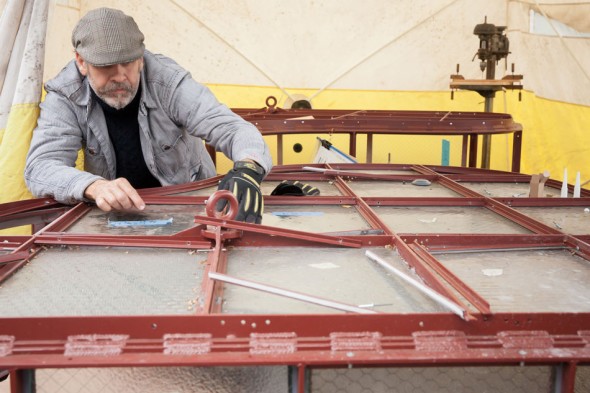
Within the industrial collage that is south of the Market art spaces lies a hidden authentic artistic revolution. The day, in its entirety, oversees a gloomy mist-filled morning and late afternoon that lingers to capture a small portion of the evening. Approaching the side streets of Alabama and 14th, the evening finally shows its glimmer, while bouncing off the walls of the previous industrialized spaces. But as of now those spaces house some of the most innovative and original artists to date. The anticipation of meeting and witnessing Brian Goggin’s installations instantly draws a curious impatience. As the evening sun approaches to kiss the windows of the Victorian homes, dusk settles in and the heights of Laurel could not be more beautiful or ingratiating.
Approaching the rustic silver gate to the home of the sculpting sensationalist Brian Goggin, I am idled to an immediate standstill. The humble sincerity upon entering Brian’s space is intriguing to say the least. With the ceiling reaching what looks to be almost forty feet in height, Brian’s workshop is decorated with the tools and materials he needs to produce his next project. One look across the room and I notice a model that Brian is currently working on for his latest masterpiece; wood and metals that I assume will work their way into a future complex installation; and lastly, the winding staircase to his living quarters that sit high above Goggin’s workshop.
Brian’s influence and sheer brilliance stem from a collective understanding of what it is to be human, but yet entertaining the idea of engaging art in concert with expressing tangible movement alone as a “site specific sculptural artist.”
Brian, how did you get your start, and where did you study? I studied filmmaking and painting while attending University of California Santa Barbara, then studied at Cambridge University for two years as a part of their abroad program through UCSB. It was then my primary professor suggested I stay on an additional year. I followed through and continued to study and in the end graduated with a double major in English and Fine Art.
I immediately noticed the piano mounted on the wall with the sail centered in the middle. What was your motivation behind this piece? Well, back in 1989, I was given this piano that was in the high school I previously attended and also later taught at for a short time, and they were going to chop this piano up as part of a bonfire. I then immediately traded it for kindling. I started working with it to try and figure out a sort of sculptural manipulation that I could do with it.

What’s your medium, and would you consider this piano piece one of your first? I call it site-specific sculptural installation. But again since the late 1980’s I would consider this particular installation one of my first.
With installations as elegant and visually appealing as yours, who or what would you say championed your inspiration? I enjoyed Fellini as a filmmaker. He was probably one of the most important influences in my life along with Werner Herzog and Fitzcarraldo.
Where would you say this motivation and influence lies now? The motivation is having a respect incorporated into high art. I enjoy having fun and incorporating that idea. But that’s probably related to the filmmaking tradition. Fellini is entertaining as well as conceptually inspiring and philosophically relevant. But I saw him as dealing with what it is to be human.
The roots of Brian Goggin’s work are planted almost organically and his artistic outlook inspires and influences a more collectively valued art movement. Having studied film, painting, sculpting and effortlessly living the life of a well-traveled artistic intellectual, Goggin’s work is indeed that of an innate elite and evolutionary dynasty. Brian’s colossal installations can be seen throughout the city of San Francisco. Although the sheer massiveness of Brian’s pieces leave onlookers mind blown, life proceeds as is, to leave its onlookers to enjoy his works yet another day.
“The Zen riddling have humor that directs you in the direction of enlightenment and in essence becoming more aware of the present moment, and also becoming more compassionate. That’s the direction that I am trying to go in with my work.”

Text by William Lankford
Photography by Michael Rauner

